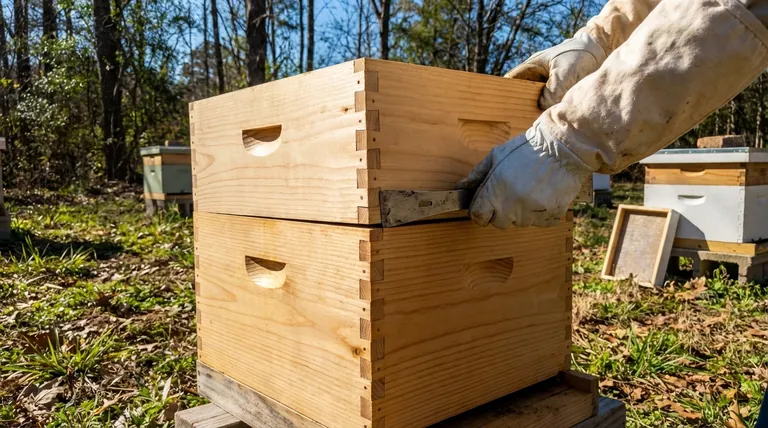The most effective way to align hive boxes is to use the flat blade of your hive tool to lever them into a perfectly flush position immediately after reassembly. This simple action prevents the bees from building disruptive propolis ridges between the boxes, ensuring a tight, weatherproof seal.
Proper hive alignment is not for aesthetics; it is a critical practice for hive integrity. Misaligned boxes encourage the creation of propolis dams that prevent a proper seal later, compromising insulation, pest defense, and the ease of future inspections.

The "Why" Behind Perfect Alignment
It's About Maintaining the Seal
A beehive is a carefully climate-controlled environment. The bees work constantly to maintain a specific temperature and humidity level that is optimal for raising brood and curing honey.
Any gap between boxes breaks this environmental seal. This forces the colony to expend extra energy and resources to fight drafts and regulate temperature, weakening them over time.
Understanding Bee Space and Propolis
Bees instinctively manage the space within their hive. They will fill any gap smaller than a "bee space" (roughly 1/4 to 3/8 of an inch) with propolis, a sticky resinous glue.
When hive boxes are misaligned, you create precisely these kinds of small, irregular gaps. The bees' natural response is to seal these cracks with propolis to eliminate drafts.
The Problem with Propolis Ridges
This becomes a problem during your next inspection. When you straighten the boxes, the hardened propolis ridge you encouraged now acts as a wedge.
This wedge prevents the boxes from ever sitting flush again, creating a permanent gap and defeating the purpose of a well-constructed hive.
The Correct Alignment Technique
Use Your Hive Tool as a Lever
After placing a hive box, do not rely on just your hands. Take the flat, wide end of your hive tool for this task.
Work All Four Corners
Insert the blade into the handhold or between the boxes at a corner. Use a gentle levering motion to nudge the box forward, backward, or sideways.
Repeat this process on all four sides of the hive, checking each corner. Your goal is a perfectly flush, seamless exterior.
Feel for a Smooth Surface
The final test is tactile. Run your hand down the corners of the stacked boxes. You should not feel any lip or edge. It should feel like a single, solid piece of wood.
Consequences of Poor Alignment
Compromised Hive Insulation
Gaps are the enemy of a wintering colony. Cold drafts that penetrate the hive force the cluster to consume more honey stores to generate heat, increasing the risk of starvation.
An Open Invitation for Pests
Pests like wax moths and small hive beetles are opportunistic. A small gap created by misaligned boxes is a perfect, defensible entry point for them to invade the colony.
Difficult Future Inspections
Boxes glued together with irregular propolis ridges are extremely difficult to separate. This increases the force needed, jarring the bees, angering the colony, and risking damage to your woodenware.
Making Alignment a Core Habit
This simple step should be the final action of every single hive inspection.
- If your primary focus is a quick inspection: Taking 10 seconds to align the boxes now will save you minutes of struggle breaking propolis seals during your next visit.
- If your primary focus is winter preparedness: Ensure every box is perfectly flush after your final autumn check to eliminate drafts and help the colony conserve its vital energy stores.
- If your primary focus is colony health: View every gap from misalignment as a weakness in the hive's defense and seal it with proper alignment.
Treating your hive as a single, sealed unit is fundamental to responsible and effective beekeeping.
Summary Table:
| Key Aspect | Why It Matters |
|---|---|
| Maintains Hive Seal | Prevents drafts, helping bees regulate temperature and humidity efficiently. |
| Prevents Propolis Dams | Stops bees from creating ridges that make future inspections difficult. |
| Improves Pest Defense | Eliminates small gaps that can serve as entry points for wax moths and hive beetles. |
| Saves Time & Effort | Proper alignment now prevents struggling with stuck boxes during the next inspection. |
Protect your investment and ensure your colonies thrive with professional-grade equipment. HONESTBEE supplies durable, precision-made beekeeping supplies and equipment to commercial apiaries and beekeeping equipment distributors through our wholesale-focused operations. Let us help you build a stronger, more productive operation. Contact HONESTBEE today to discuss your needs!
Visual Guide

Related Products
- Langstroth Honey Bee Box Hive Boxes for Different Depths
- Australian Langstroth Beehive Boxes for Beekeeping Wholesales
- Portable Bee Mating Hive Boxes Mini Mating Nucs 8 Frames for Queen Rearing
- 5 Frame Wooden Nuc Box for Beekeeping
- Automatic Heat Preservation 6 Frame Pro Nuc Box for Honey Bee Queen Mating
People Also Ask
- What are the sizes of supers available in a standard hive? A Guide to Deep, Medium, and Shallow Boxes
- How is checking honey supers in a Langstroth hive different from inspecting Honey Flow supers? A Guide to Disruptive vs. Non-Invasive Methods
- What is the best time to inspect a hive? Optimize for Bee and Beekeeper Safety
- What is the purpose of the boxes in a Langstroth hive? A Guide to Modular Beekeeping Success
- How does a hive box work? A Guide to the Langstroth Hive System for Beekeepers



















